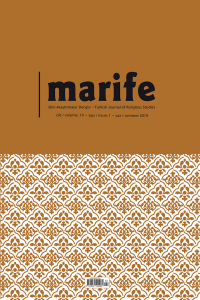
Marife Dini Araştırmalar Dergisi
Yazarlar: Aygün AKYOL
Konular:Sosyal, Felsefe
DOI:10.33420/marife.402802
Anahtar Kelimeler:Jabir Ibn Hayyan,Classification,Sciences,Islam,Epistemology
Özet: The formation and development of scientific knowledge requires a process and description of civilization. This first requires the formation of a worldview, allowing for formation of a knowledge tradition, enabling for a method and order and denominating the information clusters. This paper, to review that how philosophical and scientific approaches are assessed in our tradition, the first one we come across is Jabir Ibn Hayyan who is one of the most significant scholars of the Islamic history of thought and science. When his scientific and philosophical approaches are reviewed, it will be seen that how he has a deep infrastructure in the starting stage of Islamic thought. In the article, we will try to assess his understanding of science and classification of sciences with reference to his book called Book of Definitions. Within this context, we want to discuss what it means today. Before mentioning science understanding of Jabir Ibn Hayyan, we want to give information concerning to his life and scientific personality.